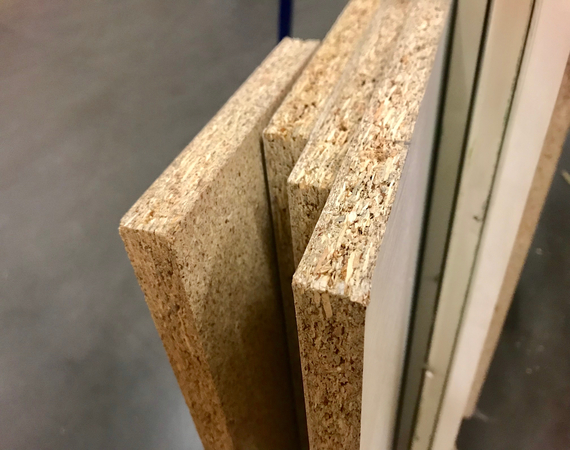MEDIUM DENSITY FIBREBOARD :

A dense product of engineered wood; medium density fibreboard or MDF is manufactured with wood fibres of either softwood or hardwood species along with a synthetic resin fibre and wax. Basically, the wood used in producing MDF is either recycled softwood/hardwood residuals or Agro-grown wood and thus makes this product Eco-friendly in a way.
More likely than not, this product is confused with particleboard but MDF is smoother as it is free of knots and grain patterns and due to its diverse physical properties and dimensions MDF has proven to take more intricate detail that gives the final product a flawless finishing. The trim interiors and moulding make the MDF panel a superior product for painting and lamination. The engineering of Medium Density Fiberboard is such that the usage of this product turns out to be relatively reasonable and affordable.
A MDF panel is highly preferred for home interiors and public places, especially in furniture, kitchen cabinets, door parts, trim moulding, mill work and even laminate flooring.
This environment friendly substitute of Plywood is moisture-resistant, termite proof, flame retardant and borer and making MDF ideal in applications like bathroom cabinets, doors and panels.
HOW IS MDF MANUFACTURED?
MDF can be manufactured with both softwood and hardwood. The process mainly includes compressing of wood chips and sawdust wherein they are cleaned and processed to remove the impurities to keep the particles small and consistent. MDF products are processed with a resin (often, formaldehyde-based), which bonds the fiber particles when they ‘recompressed. This then results in sheets of thin and strong wood. Further, these sheets are clad with thin hardwood face veneers. Additionally, even vinyl or leather can be applied to the surface of the final panel.
SPECIFICATIONS OF THE MDF SHEETS:
Standard forms of MDF have densities as follows:
- Average density: 700 – 800kg/m3.
- Core density: 600 – 700kg/m3
- Face density: 1000 – 1100kg/m3
Its usage?
Medium Density Fiberboard Panels (MDF) is widely used in the manufacture of well suited residential construction of modern homes where cabinets and built-ins showcases the performance of MDF beautifully. It is the material of choice in home interiors where tight tolerances, smooth surfaces and intricate machining are critical.
Interior trim and mouldings are easily machined and laminated or painted. MDF can be machined with extremely tight tolerances and is used frequently in interior trims.
MDF Panels are widely used in:
- Furniture
- Kitchen Cabinets
- Door Parts
- Trim Moulding
- Millwork
- Laminate Flooring
Its Properties
MDF properties are defined as:
Moisture-resistant boards are used for bathroom fitments, doors, window boards, and other interior building applications where resistance to damp conditions is an important requirement.
Flame retardant boards are increasingly used for fitted furniture, doors, and paneling in public buildings and other areas which are required to conform to specific fire regulations.
DENSITY, Mass & Panel Size
High-Density MDF (HDF)
Low-Density MDF (LDF)
Ultra-Low-Density MDF (ULDF)
Standard forms of MDF typically have densities as follows: • Average density: • Core density: • Face density: 700kg/m3 to 800kg/m3 600kg/m3 to 700kg/m3 1000kg/m3 to 1100kg/m3 MDFs can have densities that range from below 550kg/ m3 up to 800kg/m3 and above. Due to variation between brands, the weight of MDF is not constantly proportional to thickness. Table A2.24: Typical weights, based on standard MDF with average density 750kg/m3 Thickness Mass per unit area 6.5mm 5.0kg/m2 9.0mm 6.3kg/m2 12.0mm 8.4kg/m2 16.0mm 11.0kg/m2 19.0mm 14.0kg/m2 MDF is available in an extensive range of thicknesses, 1.8mm to 60mm. The most common panel sizes are: widths 1220mm, 1525mm and 1850mm and lengths up to 3660mm with the most common being 2400mm. Other sizes are available or can be produced to order (minimum order conditions exist). With the exception of the largest users, such as volume furniture manufacturers, MDF in common with other wood-based panels would generally not be supplied directly by the manufacturer but instead, depending on the volume and specification, could be supplied through a distributor or merchant
Applications
Due to the particular machining and finishing attributes combined with good working properties and its availability in a wide range of panel thicknesses and sizes, MDF is used in a wide range of construction and furniture applications. It is used increasingly for interior design and building applications such as skirting panels and architraves, window boards, wall linings and decorative facades, as well as the core material for some flooring. MDF can be cut without breakout or splintering and it can be profiled on the edges and surfaces. The smooth and relatively dense surface provides an excellent base for painting, veneering, and laminating. Consequently, MDF is used extensively in furniture production and with the range of value-added variants, its use is being extended into shopfitting and display, interior fitments, exterior application (such as signage and shop fronts) as well as components within numerous other products.
Storage & Handling
Careful storage and handling is important to maintain panels in their correct condition for use; it is, therefore, imperative that particleboard is protected from rain and accidental soaking. During transport, it is particularly important to keep edges well covered. Panels should be stored flat in an enclosed, dry building. When handling panels, the edges and corners should be protected against damage. ‘Humid’ MDF panels can tolerate inflated humidity conditions such as can be found in kitchens and bathrooms but direct contact between the unprotected panel and water should be avoided.
